Chevrolet shows off features to make towing easier and safer
Breadcrumb Trail Links
Technology & InnovationHow it works
And several of these high-tech features and applications were developed here in Canada
Published May 17, 2024 • 7 minute read
You can save this article by registering for free here. Or sign-in if you have an account.
 Silverado Heavy-Duty with RV trailer Photo by Jil McIntosh
Silverado Heavy-Duty with RV trailer Photo by Jil McIntosh
Article content
There are many reasons why people want pickup trucks, and one of the big ones is towing. Automakers are adding numerous technologies to make towing easier, and I recently pulled trailers behind some of Chevrolet’s trucks to see what’s available.
Advertisement 2
This advertisement has not loaded yet, but your article continues below.
Article content
Between laps on General Motors’ new test track in Oshawa, Ontario, and a short stint on the highway, I got to experience technologies including blind-spot monitoring with trailer coverage, trailering apps and views including a “transparent” trailer and backing guidelines, and Super Cruise hands-free highway driving assist. Interestingly, many of these features were developed by GM’s engineers in Canada. I also towed with Chevrolet’s newest truck, the all-electric Silverado EV.
Mind you, as good as they are, none of these technologies are going to instantly turn neophytes into towing experts their first time out. They can make everything easier and safer, but they’re not a substitute for practice, practice, practice. Some may only be standard or optional equipment depending on the truck’s trim. And while some of the individual technologies are proprietary, most features overall aren’t unique to General Motors, and other automakers offer their own versions on their vehicles.
Advertisement 3
This advertisement has not loaded yet, but your article continues below.
Article content
Learn more about the cars
PREV
2024 Chevrolet Silverado 1500
MSRP $44,899 to $86,699
2024 Chevrolet Equinox
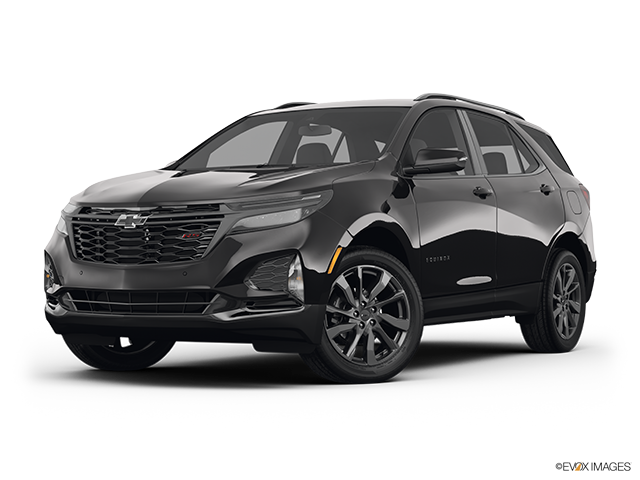
MSRP $28,945 to $36,645
2024 Chevrolet TrailBlazer
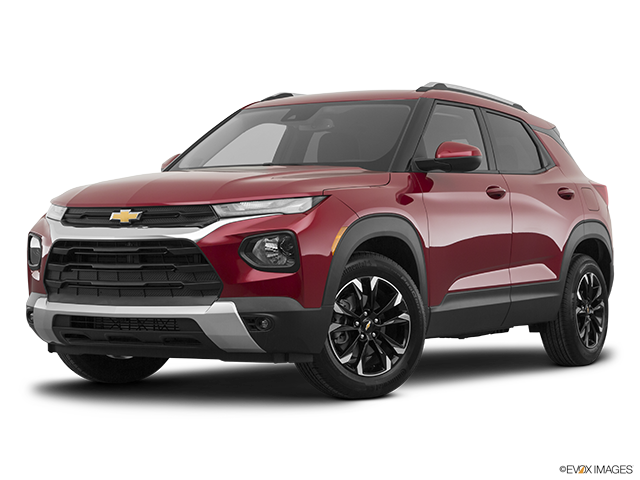
MSRP $26,699 to $32,999
2023 Chevrolet Bolt EUV
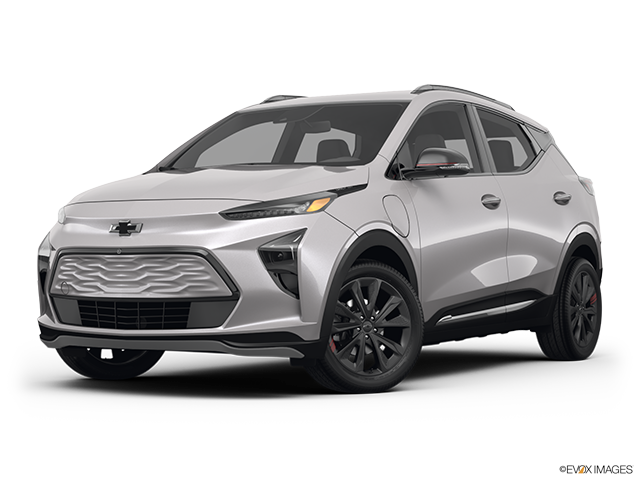
MSRP $40,548 to $44,048
2023 Chevrolet Bolt EV
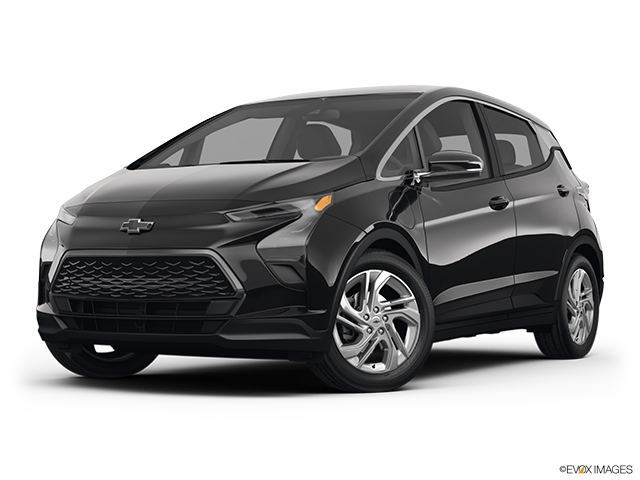
 The side blind zone alert warns if a vehicle is alongside and also indicates the length of the truck and trailer Photo by Jil McIntosh
The side blind zone alert warns if a vehicle is alongside and also indicates the length of the truck and trailer Photo by Jil McIntosh
Trailering with Side Blind Zone Alert
Blind-spot monitoring is common on most vehicles today. It gives you a warning when there’s a vehicle alongside, and ramps up that message if you activate your turn signal to change lanes. The trailering version also includes what’s alongside the trailer. You can pull up a camera view on the centre infotainment screen that projects a red rectangle beside the trailer – which was developed in the Ontario facility, and which GM’s engineers have dubbed the “red carpet.” It’s handy because you can also see vehicles farther back that aren’t yet alongside, and you’ll be cutting it close – and cutting them off – if you move over.
To let the system know how much space you’ll need, you input your trailer’s length into the trailering app. What’s that app all about, you ask? Well, read on…
Advertisement 4
This advertisement has not loaded yet, but your article continues below.
Article content
 The automated light check indicates an issue with the trailer’s turn signal Photo by Jil McIntosh
The automated light check indicates an issue with the trailer’s turn signal Photo by Jil McIntosh
In-Vehicle Trailering App
GM’s in-vehicle trailering app is accessed through the centre screen. You input your trailer’s information, including its length and type, and assign a profile to it. It can store up to five trailers; and beyond that, if you have an applicable OnStar plan, you can further add up to 25 more in that, useful for fleet managers.
After a trailer’s hooked up, you tap its profile on the screen. That provides its length to the side zone alert, and also keeps a running tab on how many kilometres it’s logged behind your truck. Other app features depend on the truck’s level of equipment. These can include a trailer light check, which confirms the brake lights and turn signals, and indicates any that aren’t working; trailer maintenance reminders; and it can keep tabs on the pressure and temperature of the trailer’s tires, providing you’ve had GM-specific wireless tire pressure monitoring system (TPMS) sensors installed in the wheels.
Advertisement 5
This advertisement has not loaded yet, but your article continues below.
Article content
Recommended from Editorial

How much can your truck really tow? We crunch crew-cab numbers

2024 Chevrolet Silverado EV Work Truck eases transition from gas to EV
There’s also a checklist of everything to remember when you’re hooking up the trailer. And should someone unhook your trailer with the intent of it no longer being your trailer but theirs, the app will trigger the truck’s alarm to go off. If you have the appropriate OnStar program, you’ll also get a notification on your phone. Should you hook your trailer to another Chevrolet or GMC truck with the same in-vehicle app, you can download the trailer’s profile into that truck through your phone, which will allow you to use the trailering app and log the mileage you put on the trailer during that trip.
Advertisement 6
This advertisement has not loaded yet, but your article continues below.
Article content
 The Transparent Trailer view uses a rear camera to show what’s behind the trailer Photo by Jil McIntosh
The Transparent Trailer view uses a rear camera to show what’s behind the trailer Photo by Jil McIntosh
Transparent Trailer
The Transparent Trailer feature first appeared on the 2020 GMC Sierra Heavy-Duty, and has since been rolled out on other GM trucks and large SUVs. Up to 14 camera views are available on the Chevy Silverado, including the hitch, the bed, and side views along the truck, so you can easily see the trailer across its width. The transparent view makes the trailer “disappear” – you can see its outline in the centre screen, but it’s as if you’re looking through it at what’s in behind it.
If you activate the turn signal, the view temporarily changes to the blind zone alert view, and then goes back to the transparent view once you’re done. It’s a pretty cool feature, but note that it requires you to purchase and install a wired camera on the back of the trailer – the Transparent Trailer view won’t work without it. Also available is a camera that goes inside the trailer to provide a view there, which could be handy for people who tow horse trailers, and which can be installed by itself or alongside the rear camera.
Advertisement 7
This advertisement has not loaded yet, but your article continues below.
Article content
 Reverse guidance lines and a trailer angle indicator help with backing up a trailer Photo by Jil McIntosh
Reverse guidance lines and a trailer angle indicator help with backing up a trailer Photo by Jil McIntosh
More on trailer views…
The demonstration for the various trailer views involved backing a snowmobile trailer into a spot between two pylons. Now, as mentioned, trailering is about practice, practice, practice. And I don’t get a lot of it, because I’m not into camping, RVing, or snowmobiling – and as a result, like a lot of drivers, I’m not particularly talented when it comes to reversing a trailer. The rear view included yellow guidelines that moved with my front wheels, and by turning the steering wheel to keep them in line with the pylons, I was able to put the trailer there with no issues. The view also provides an indicator that warns if the trailer angle is getting too sharp and in danger of a jackknife.
 The Super Cruise hands-free driving assist is active when the steering wheel light turns green Photo by Jil McIntosh
The Super Cruise hands-free driving assist is active when the steering wheel light turns green Photo by Jil McIntosh
Super Cruise Trailering
Advertisement 8
This advertisement has not loaded yet, but your article continues below.
Article content
Super Cruise is GM’s name for its available hands-free driving assist feature, which works on pre-mapped highways. You still have to pay attention – it monitors your head and requires that you take the wheel if you’re not looking forward – but it lets you sit back while it steers. On the most sophisticated versions, it will change lanes on-demand if you tap the turn signal switch, or even do it automatically if the vehicle comes up behind slower traffic, of course after it uses its blind-spot system to see if it’s safe.
Once on the highway, the truck gave me a message that Super Cruise could be used, and so I set it – a light on the steering wheel turns green to indicate it’s operating – and let go of the wheel, and truck and trailer went on by themselves. When a trailer is hooked up, Super Cruise won’t change lanes, either on-demand or automatically. In theory, it probably could, but there’s always the possibility the driver hasn’t entered the trailer’s length properly and so it’s best to stay on the side of caution.
Advertisement 9
This advertisement has not loaded yet, but your article continues below.
Article content
Toggle full screen modePrevious Gallery Image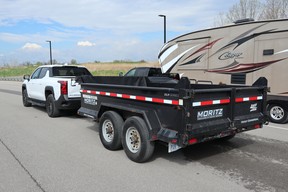
Silverado EV 4WTPhoto by Jil McIntosh
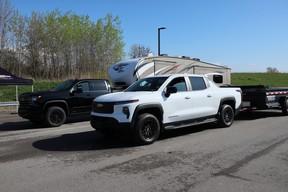
Diesel and electric Chevrolet Silverados on a test trackPhoto by Jil McIntosh
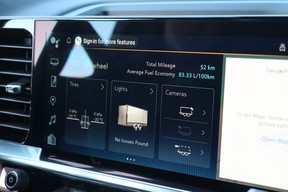
The trailer profiles can keep track of the trailer mileage and, if properly equipped, its tire pressure and temperaturePhoto by Jil McIntosh
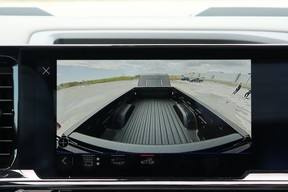
A camera view of the truck bed, handy for checking items in the bedPhoto by Jil McIntosh
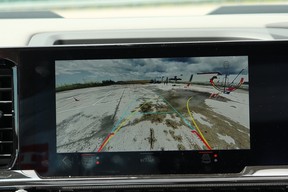
Reverse guidance lines and a trailer angle indicator help with backing up a trailerPhoto by Jil McIntosh
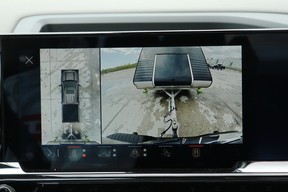
An overhead hitch viewPhoto by Jil McIntosh
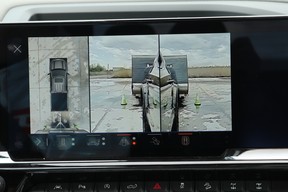
A trailering view down the truck's sides enables a view of the trailer width
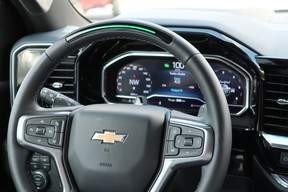
The Super Cruise hands-free driving assist is active when the steering wheel light turns greenPhoto by Jil McIntosh
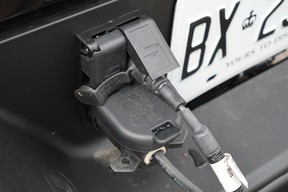
The plug for the available trailer rear camera, needed for the Transparent Trailer viewPhoto by Jil McIntosh
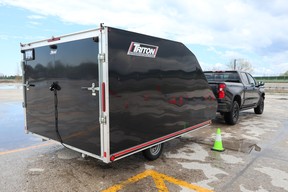
The Transparent Trailer view requires an optional rear-mounted trailer cameraPhoto by Jil McIntosh
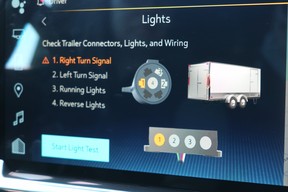
The automated light check indicates an issue with the trailer's turn signalPhoto by Jil McIntosh
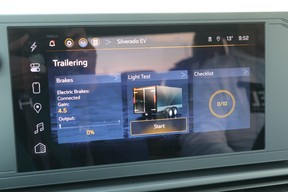
The trailering app on the Silverado EV's centre screenPhoto by Jil McIntosh
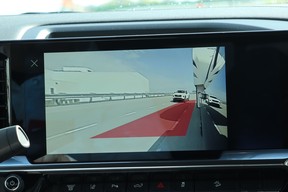
The side blind zone alert warns if a vehicle is alongside and also indicates the length of the truck and trailerPhoto by Jil McIntosh
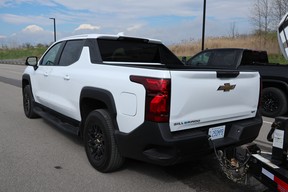
Silverado EV 4WTPhoto by Jil McIntosh
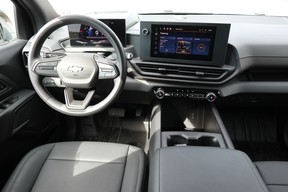
Silverado EV 4WTPhoto by Jil McIntosh
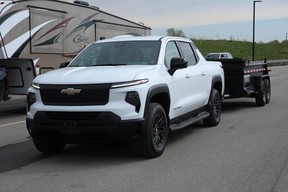
Silverado EV 4WTPhoto by Jil McIntosh
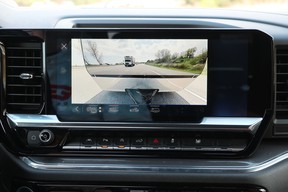
The Transparent Trailer view uses a rear camera to show what's behind the trailerPhoto by Jil McIntosh

Silverado Heavy-Duty with RV trailerPhoto by Jil McIntosh
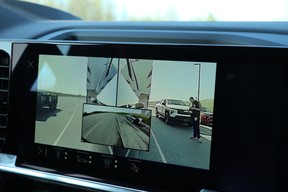
The centre screen can display one view or several at oncePhoto by Jil McIntosh
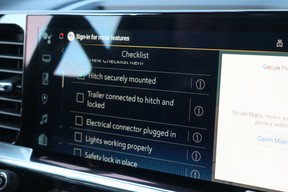
A checklist in the trailering appPhoto by Jil McIntosh
Next Gallery ImageToggle gallery captions
All 20 Photos for Gallery
Function Not Available
Full Screen is not supported on this browser version.
You may use a different browser or device to view this in full screen.
OK
But what Super Cruise does do with a trailer is pretty slick. The driver can adjust the gap – the pre-set distance the truck will stay behind a vehicle in front. The system uses data from the truck’s transmission and brakes to roughly calculate what the trailer weighs, and from there, it adjusts the gap accordingly. Even if you’ve set it for the shortest distance, the truck will stay farther back if it determines it’s not enough stopping distance. And if it detects the trailer’s overloaded, the navigation system will show the location of the closest public weigh scales. That’s a cool feature (providing overloaded drivers take advantage of it), as is GM’s practice of putting each individual truck’s gross combined weight rating (GCWR) on the door jamb label. That’s the maximum allowable combined weight of the truck, trailer, and everything that’s in both, and which can be affected by the truck’s configuration and options. (Whenever you see high towing numbers advertised in truck ads, that’s the maximum for the entire lineup, and some models within it will have a lower towing capacity.)
Advertisement 10
This advertisement has not loaded yet, but your article continues below.
Article content
 Silverado EV 4WT Photo by Jil McIntosh
Silverado EV 4WT Photo by Jil McIntosh
And finally, the Silverado EV…
While it isn’t a trailering technology, GM added this to the event for the sake of putting a trailer on the Silverado EV’s hitch. It isn’t a gasoline Silverado with an electric motor in place of an engine, but is built as an EV from the ground up on GM’s “Ultium” EV platform, as is the GMC Hummer EV pickup and, for that matter, all of GM’s electric vehicles going forward.
It comes in three trims, starting with the 3WT (Work Truck), with an estimated range of 632 km on a charge. At the top end, the fancier RST gets 708 km, but for this event, I was in the middle-trim 4WT, with an estimated 724 km. The 3WT has a maximum towing capacity of 12,500 lbs, while the 4WT’s larger battery reduces that trim’s capacity to 10,000 lbs. My truck was pulling 5,000 lbs, which cut into its range by about 30 per cent – and which is one of the issues for electric trucks, so buyers will have to calculate how it fits their needs. It’s impossible to get a full impression of a truck with just a couple of laps around a test track, but it had no trouble getting the trailer up to speed, and the truck handled smoothly and accurately. And like its gasoline and diesel cousins, it was also equipped with several of the trailering features, for those who appreciate a bit of technology when it’s time to tow.
More in How it works
See more
Share this article in your social network
Jil McIntosh
Jil McIntosh specializes in new-car reviews, auto technology and antique cars, including the two 1940s vehicles in her garage. She is currently a freelance Writer at Driving.ca since 2016
Summary
· Professional writer for more than 35 years, appearing in some of the top publications in Canada and the U.S.
· Specialties include new-vehicle reviews, old cars and automotive history, automotive news, and “How It Works” columns that explain vehicle features and technology
· Member of the Automobile Journalists Association of Canada (AJAC) since 2003; voting member for AJAC Canadian Car of the Year Awards; juror on the Women’s World Car of the Year Awards
Education
Jil McIntosh graduated from East York Collegiate in Toronto, and then continued her education at the School of Hard Knocks. Her early jobs including driving a taxi in Toronto; and warranty administration in a new-vehicle dealership, where she also held information classes for customers, explaining the inner mechanical workings of vehicles and their features.
Experience
Jil McIntosh is a freelance writer who has been writing for Driving.ca since 2016, but she’s been a professional writer starting when most cars still had carburetors. At the age of eleven, she had a story published in the defunct Toronto Telegram newspaper, for which she was paid $25; given the short length of the story and the dollar’s buying power at the time, that might have been the relatively best-paid piece she’s ever written.
An old-car enthusiast who owns a 1947 Cadillac and 1949 Studebaker truck, she began her writing career crafting stories for antique-car and hot-rod car club magazines. When the Ontario-based newspaper Old Autos started up in 1987, dedicated to the antique-car hobby, she became a columnist starting with its second issue; the newspaper is still around and she still writes for it. Not long after the Toronto Star launched its Wheels section in 1986 – the first Canadian newspaper to include an auto section – she became one of its regular writers. She started out writing feature stories, and then added “new-vehicle reviewer” to her resume in 1999. She stayed with Wheels, in print and later digital as well, until the publication made a cost-cutting decision to shed its freelance writers. She joined Driving.ca the very next day.
In addition to Driving.ca, she writes for industry-focused publications, including Automotive News Canada and Autosphere. Over the years, her automotive work also appeared in such publications as Cars & Parts, Street Rodder, Canadian Hot Rods, AutoTrader, Sharp, Taxi News, Maclean’s, The Chicago Tribune, Forbes Wheels, Canadian Driver, Sympatico Autos, and Reader’s Digest. Her non-automotive work, covering such topics as travel, food and drink, rural living, fountain pen collecting, and celebrity interviews, has appeared in publications including Harrowsmith, Where New Orleans, Pen World, The Book for Men, Rural Delivery, and Gambit.
Major awards won by the author
2016 AJAC Journalist of the Year; Car Care Canada / CAA Safety Journalism award winner in 2008, 2010, 2012 and 2013, runner-up in 2021; Pirelli Photography Award 2015; Environmental Journalism Award 2019; Technical Writing Award 2020; Vehicle Testing Review award 2020, runner-up in 2022; Feature Story award winner 2020; inducted into the Street Rodding Hall of Fame in 1994.
Contact info
Email: [email protected]
Linkedin: https://www.linkedin.com/in/jilmcintosh/
Twitter: https://twitter.com/JilMcIntosh
POPULAR VEHICLE COMPARISONS
Driving.ca's Blind-Spot Monitor
By clicking on the sign up button you consent to receive the above newsletter from Postmedia Network Inc. You may unsubscribe any time by clicking on the unsubscribe link at the bottom of our emails or any newsletter. Postmedia Network Inc. | 365 Bloor Street East, Toronto, Ontario, M4W 3L4 | 416-383-2300
Thanks for signing up!

